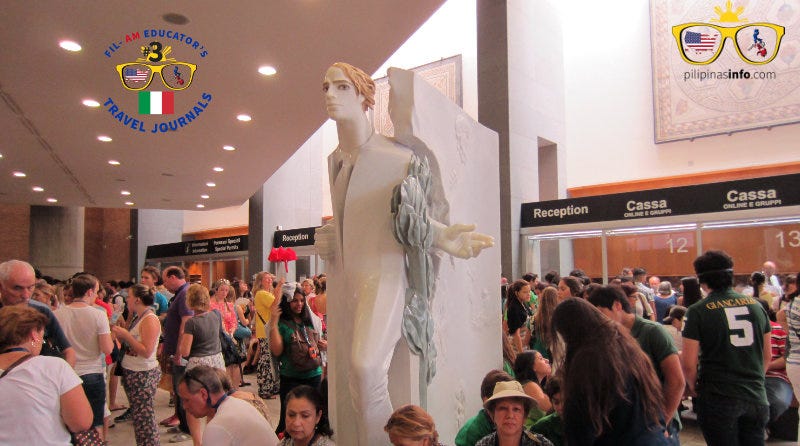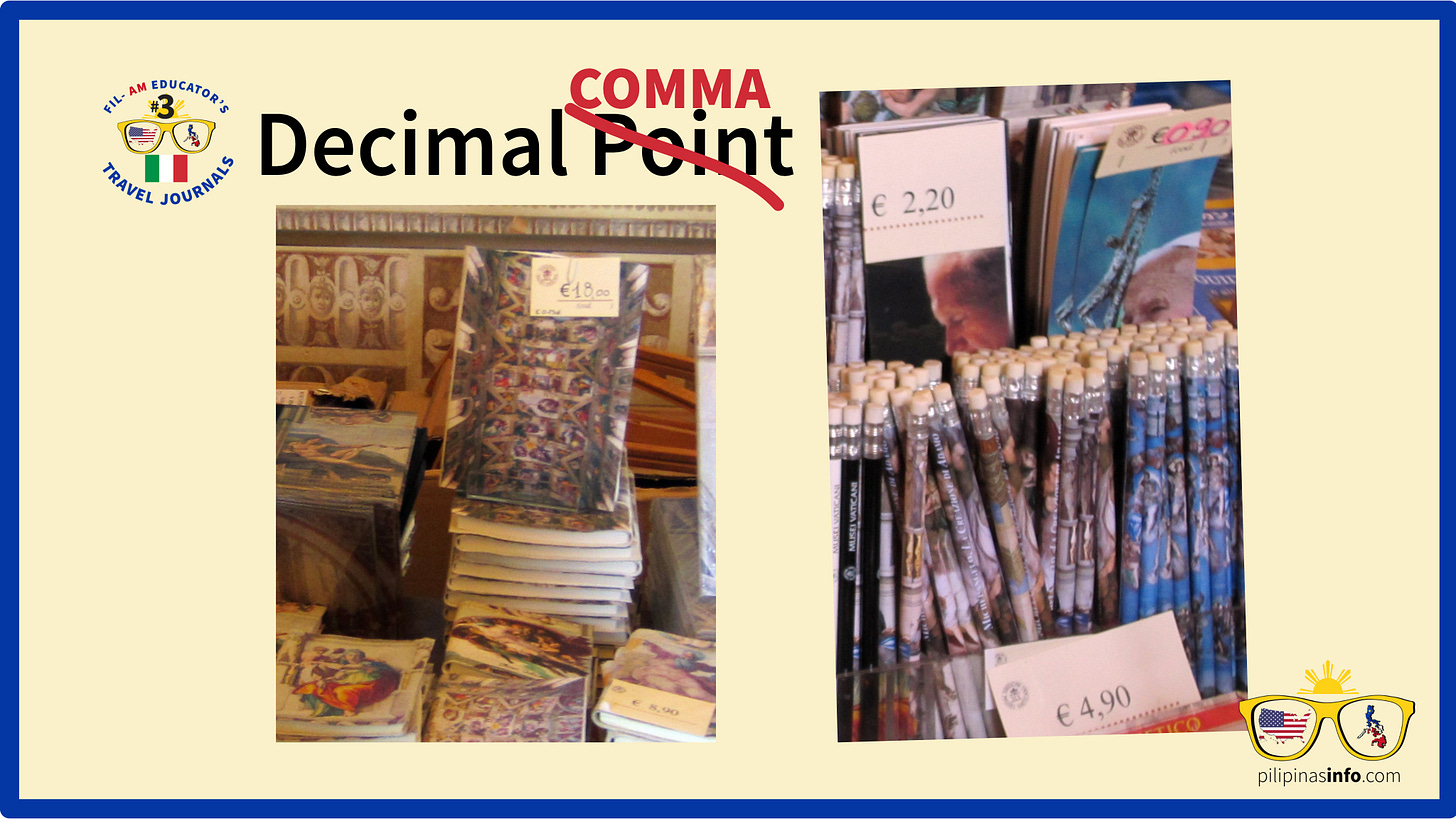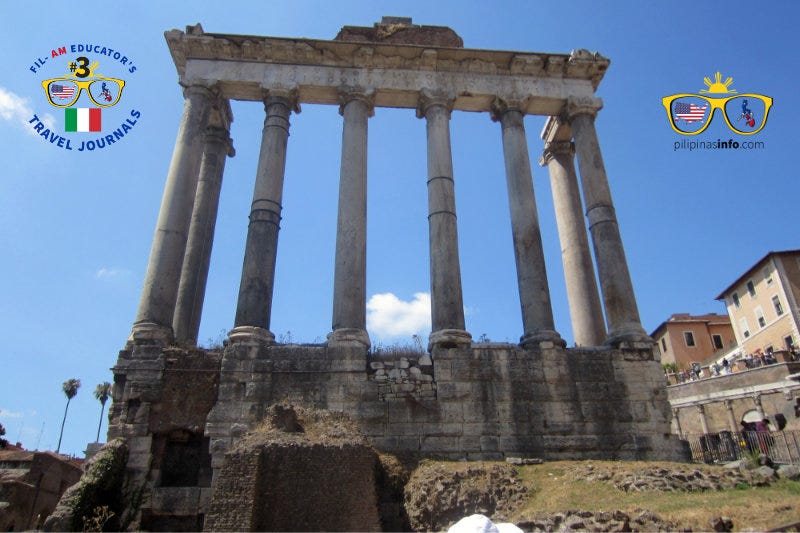Different Values seen in Vatican: Perception, Place Values etc. in Rome
2012 Italy Travel Observations of a Bilingual SPED Teacher Day No. 3
This is the third post about my trip to Italy in the summer of 2012. It was one of my requirements to complete the GWU Education Specialist Degree that was granted through the partnership of US Education Department, the school district I worked for and George Washington University. Even then, I was writing from the POV of a Filipino Educator teaching in the USA. There are hidden gems in these journal entries worthy to be shared.
Our visit to Vatican City and Sistine Chapel as I expected: statues, paintings, buildings and lots of people. It is easy to disregard a beautiful statue like the one shown below near the ticket counter. Vatican is full of treasures that visitors do not know which to appreciate more. Others also try to disregard their importance. For example, a young man put a cap on the statue shown below. Suddenly, three guards were on the scene and corrected the situation.
I do not know the name of the statue above but the immediate response of the guards indicate that any artwork inside the Vatican is being watched.
What Tourists Do Not Value is Valuable
The people in the picture above might not appreciate this statue, and the young man who climbed it to put a cap may not respect it, but Vatican values it and all visitors should do likewise. As educators, it is our duty to tell our students to value everything. It might not seem important to us but it is to others.
Value of a Focal Point
New places, people and things tend to overwhelm us. It is always good to have a focal point. Once we are comfortable with our focal point, we should then expand our senses and perception. My students, who have intellectual disabilities and English learners, will benefit from using a focal point. I know that they are overwhelmed by most lessons so I try my best to simplify worksheets, articles and handouts for them. I know that when they complain or misbehave, they either do not understand or are overwhelmed by the task. Vatican City is like that overwhelming task. Too many artwork, too much history, too many noisy people trying to listen to their guides.
Comma Instead of Period for Place Value
The picture above shows souvenir items you can buy inside the Vatican. However, what interest me is their numerical system. American prices use a dot to separate dollars from cents. Euros, on the other hand, use a comma as their decimal point. I heard that some Hispanic countries also use this numerical system and I was awestruck with its implication in the way I teach Math to my Hispanic students. They might be confused with the comma and the dot and I just assumed that they do not know. I never asked them about their numerical system. If I did, a simple lesson on cultural differences may make a big difference in the way they absorb Math lessons.
Influence of Roman Civilization
The ruins of the Roman Forum and the Colosseum clearly stand for the old glory and rule of the once mighty Roman Empire. The foundation of civilization flowed from Greece and Rome but it was from Italy's “militaristic Rome” and “Renaissance centers of art and learning” that influenced major worldviews. (Eastman, 1985, p. 316) We visited the Colosseum and Forum and all I can think of is the former glory of Rome still influence modern society. Like the columns shown in the picture below, Roman influence still exist.
For example, the tour guide talked about the pagan celebration, Saturnalia, which was celebrated in the Roman Forum. Many religious scholars say that Catholics adopted Saturnalia and made it into Christmas celebration. I am sure that I have many teaching practices and beliefs that may have sprung from Roman civilization. Like the proud columns in the Forum, they still exist like the calendar system. Even the names of the months that I regularly teach my special needs students are Roman in origin: January came from Janus who has two faces; August from Augustus; and December means the tenth month of the Roman year.
Shopping and Meeting Filipino OFWs
In the afternoon, I went shopping near the Piazza della Repubblica and Termini Station. I learned one useful Italian word: saldi which means “sale.” At the McDonalds in the underground of the Termini Station, I was pleasantly surprised to hear Tagalog again. I realized that most of them are the Filipino overseas domestic helpers who are socializing during their Saturday day off. The Philippines is one of the leading suppliers of overseas workers and many go to Italy and other countries to work as domestics. Some of them are actually professionals who just want to earn more, build better houses and send their children to private school. They know that they will only work “abroad” for a limited time and send all they can to help their families have a better life. Of course, some of them do not succeed especially those who go to the Middle East. Still, they strive and do their best to earn in foreign countries like Italy. At the Termini station, I smiled at my kababayans (countrymen) and silently gave them a mental salute. Next, we visited the Rome International School, which is an International Baccalaureate (IB) School.





